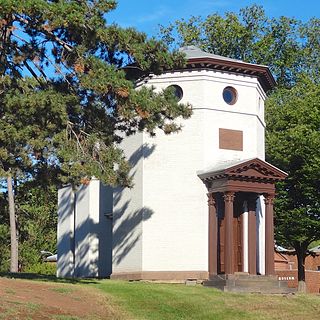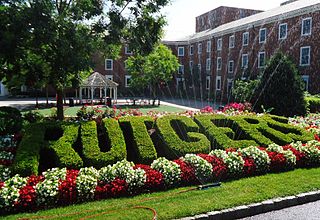
Rutgers, The State University of New Jersey, commonly referred to as Rutgers University, or RU, is an American public research university in New Jersey. It is the largest institution of higher education in New Jersey.
Richard Levis McCormick is a historian, professor and president emeritus of Rutgers University.

The Reverend Jacob Rutsen Hardenbergh, D.D., S.T.D., was an American Dutch Reformed clergyman, colonial and state legislator, and educator. Hardenbergh was a founder of Queen's College—now Rutgers, The State University of New Jersey—in 1766, and was later appointed as the college's first president.

New Brunswick Theological Seminary is a Reformed Christian seminary with its main campus in New Brunswick, New Jersey. It was founded in 1784 and is the oldest independent Protestant seminary extant in the United States. It is one of two operated by the Reformed Church in America (RCA), a mainline Reformed Protestant denomination in Canada and the United States that follows the theological tradition and Christian practice of John Calvin. First established in New York City under the leadership of the Rev. John Henry Livingston, who instructed aspiring ministers in his home, the seminary established its presence in New Brunswick in 1810. Although a separate institution, the seminary's early development in New Brunswick was closely connected with that of Rutgers University before establishing its own campus in the city in 1856. Since 1986, the seminary has also offered classes at a satellite campus on the grounds of St. John's University in the Jamaica neighborhood of Queens, New York.
The Daily Targum is the official student newspaper of Rutgers, the State University of New Jersey. Founded in 1869, it is the second-oldest collegiate newspaper in the United States. The Daily Targum is student written and managed, and boasts a circulation of 5,000 in 2017. In its current form, it exists as a bi-fold tabloid-style paper featuring international, national, local, and university news, as well as editorials, columns, comics, classifieds, sports, and other amusements. In 1980, the paper achieved independence from the University, establishing a non-profit organization, the Targum Publishing Company, which now oversees all areas of the paper. The Daily Targum is published Monday through Friday while classes are in session, in New Brunswick, New Jersey.
The Newark Targum is a weekly student newspaper published by the TargumPublishing Company for the student population of the Newark campus of Rutgers University. It is a weekly paper, with a circulation of 5,000 copies, printed each Wednesday during the academic year. It exists as a bi-fold tabloid-sized newspaper, similar to the Daily Targum the daily newspaper at Rutgers University published since 1869 on the university's main campus in New Brunswick, New Jersey.

Old Queens is the oldest extant building at Rutgers University and is the symbolic heart of the university's campus in New Brunswick in Middlesex County, New Jersey in the United States. Rutgers, the Eighth-oldest college in the United States, was founded in 1766 during the American colonial period as Queen's College a decade before the start of American Revolution. Queen's College was named for Charlotte of Mecklenburg-Strelitz, the daughter of a German duke who became the queen consort of British king George III. Old Queens is located on a six-acre hilltop city block bounded by Somerset Street, Hamilton Street, College Avenue and George Street that was previously an apple orchard. Donated to the college in 1807 by James Parker, Jr., this city block become known the Queen's Campus and is the historic core of the university. Because of this, by metonymy, the name "Old Queens" came to be used as a reference to Rutgers College and is often invoked as an allusive reference to the university or to its administration.

Voorhees Mall is a large grassy area with stately shade trees on a block of about 28 acres (0.11 km²) located on the College Avenue Campus of Rutgers University near downtown New Brunswick, New Jersey. An eclectic mix of architectural styles, Voorhees Mall is lined by many historic academic buildings. The block is bound by Hamilton Street, George Street (north), College Avenue (south) and Seminary Place (west). At the mall's western end, across Seminary Place, is the campus of the New Brunswick Theological Seminary, whose history is intertwined with the early history of Rutgers University. Across Hamilton Street is the block called Old Queens, the seat of the university.

Livingston Campus, originally named Kilmer Area by Rutgers University in 1965, and later known as Kilmer Campus, is one of the five sub-campuses that make up Rutgers' New Brunswick/Piscataway area campus. The campus was originally built to house Livingston College. The majority of its land is the Rutgers Ecological Preserve. Most of the campus is within the boundaries of Piscataway, but parts extend into Highland Park and Edison.
The Rutgers–Princeton Cannon War refers to a series of incidents involving two Revolutionary War cannons and a rivalry between the College of New Jersey in Princeton, New Jersey – now Princeton University – and Rutgers College – now Rutgers University – in New Brunswick, New Jersey.

Rutgers University – New Brunswick is one of three regional campuses of Rutgers University, New Jersey's public research university. It is located in New Brunswick and Piscataway. It is the oldest campus of the university, the others being in Camden and Newark. The campus is composed of several smaller campuses: College Avenue, Busch, Livingston,Cook, and Douglass, the latter two sometimes referred to as "Cook/Douglass," as they are adjacent to each other. Rutgers – New Brunswick also includes several buildings in downtown New Brunswick.

Merrill Edwards Gates, LL.D. was the ninth President of Rutgers College serving from 1882 to 1890, and the sixth President of Amherst College, serving from 1890 to 1899.

The Sophia Astley Kirkpatrick Memorial Chapel, known as Kirkpatrick Chapel, is the chapel to Rutgers, The State University of New Jersey and located on the university's main campus in New Brunswick, New Jersey in the United States. Kirkpatrick Chapel is among the university's oldest extant buildings, and one of six buildings located on a historic section of the university's College Avenue Campus in New Brunswick known as the Queens Campus. Built in 1872 when Rutgers was a small, private liberal arts college, the chapel was designed by architect Henry Janeway Hardenbergh at the beginning of his career. Hardenbergh, a native of New Brunswick, was the great-great-grandson of Rutgers' first president, the Rev. Jacob Rutsen Hardenbergh. It was the third of three projects that Hardenbergh designed for the college.

Benjamin Van Campen Taylor (1846–1906) was a late nineteenth- and early twentieth-century American architect.

Geology Hall, formerly Geological Hall, also known the Rutgers Geology Museum, is a building located in the historic Queens Campus section of Rutgers, The State University of New Jersey's College Avenue Campus in New Brunswick, New Jersey, United States. As part of the Queen's Campus historic district, Geology Hall was included on the New Jersey Register of Historic Places and the National Register of Historic Places in 1973. When Rutgers was selected as New Jersey's only land grant college in 1864, the college began to expand its curriculum to include instruction in science and agriculture. Rutgers president William Henry Campbell raised funds to construct a building to accommodate this expansion, and Geology Hall, designed by architect Henry Janeway Hardenbergh, was built in 1872.

The Daniel S. Schanck Observatory is an historical astronomical observatory on the Queens Campus of Rutgers University in New Brunswick, New Jersey, United States, and is tied for the seventh oldest observatory in the US alongside the Vassar College Observatory. It is located on George Street near the corner with Hamilton Street, opposite the parking lot adjacent to Kirkpatrick Chapel, and to the northeast of Old Queens and Geology Hall.

The Queens Campus or Old Queens Campus is a historic section of the College Avenue Campus of Rutgers, The State University of New Jersey in New Brunswick, New Jersey, in the United States.

College Avenue is the oldest campus of Rutgers University – New Brunswick, in New Brunswick, New Jersey, U.S. It includes the historic seat of the university, known as Old Queens. Many classes are taught in the Voorhees Mall area, also home to the Zimmerli Art Museum. The grounds of the New Brunswick Theological Seminary are within the campus area, which is within walking distance of shops, restaurants, and theaters in downtown New Brunswick. It is served by Rutgers Campus Buses, a zero-fare bus network.
















